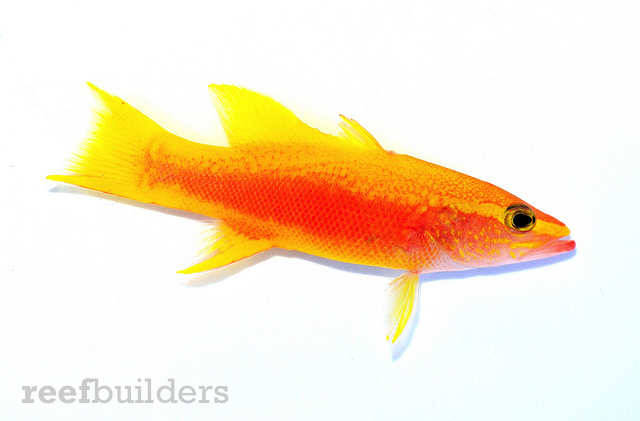Our first Awesome Fish Spotlight for 2015 goes to the infallibly lavish Liopropoma aberrans, otherwise known as the Golden Basslet. L. aberrans is a cornea scorching fish with an incredibly vibrant combination of saturated yolk-yellow, bleeding into a rich tangerine toward the centre. The zone where the two colours mix is replete with a honeycomb reticulated pattern which is most prominent near the dorsal region of the fish. While relatively new in the aquarium scene, L. aberrans has been around for more than a hundred years, being originally described way back in 1860.
L. aberrans was the first of its kind to be described back in 1860 by Poey, although at that time it was placed in the genus Perca. Subsequently, the genus Liopropoma (Gill) was erected and no further species was placed in Perca. Throughout the years, multiple Liopropoma species were discovered and placed in various genera such as Pikea, Ypisgramma, Chorististium and Labracopis. The history of these genera and their current state today are available through casual reading online, but finally these now defunct genera, with the exception of Perca, are all relegated to junior synonyms. Perca to this day remains valid, and serves as a genus for freshwater perches.
Needless to say, Perca aberrans was redescribed, and after multiple shuffling, finally ended up as Liopropoma aberrans. To this date, Liopropoma serves as the only genus for our beloved reef basslets, but within the genus are certain individuals who are different enough to see why so many junior synonyms were created back then.

Despite the 155 years of its scientific existence, it was only in 2011 when Liopropoma aberrans first gained significant awareness in the aquarium trade. Being found primarily between 330-490 ft in Curacao, very little was known about these fish and likewise, very few specimens were ever collected.
In the recent years that the curasub has been in operation, we’ve begun to see new specimens and information regarding this species, particularly from the Smithsonian Institute. To make matters more complicated, it was during this honeymoon period where deepwater exploration revealed two additional similar looking Liopropoma species.

The then unknown specimens were superficially similarly coloured, and were also known as “golden basslets”. It was only in 2014 last year when both were described within a week of each other as Liopropoma santi and Liopropoma olneyi. Apart from the more subdued and yellowish coloration, L. santi and L. olneyi are found much deeper than L. aberrans as seen from the chart above.
With the confusion finally laid to rest, the two new members are now official members of the L. aberrans complex. Unlike many other species of Liopropoma however, Barry Brown notes that L. aberrans is found mostly “in little caves or parked next to solitary stones, never near the walls. They seem to love areas near sandy slopes or little rubble piles the most and are always found hidden behind rocks most likely so they can ambush prey.”
This is curious considering many of the smaller indo-pacific Liopropoma species frequent steep reef walls with large networks of cracks. Perhaps the size and behaviour of various Liopropoma species dictates the nature and habitat they prefer. After all, our similarly sized L. fasciatum behaves in a way unlike any small Liopropoma we’ve ever seen, preferring to swim more openly, but still within the safety of rock work.
This studly specimen of L. aberrans dressed in shiny regalia was offered to Iwarna Aquafarm of Singapore by Dynasty Marine. Singapore is not the only one to cash in on the gold however. Koji Wada of BlueHarbor also acquired a specimen late last year, this time a much rarer but more subdued juvenile. The specimen can be seen in video above.



